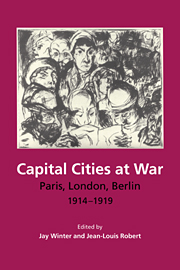Book contents
- Frontmatter
- Contents
- Note on joint authorship
- List of figures
- List of tables
- Part 1 Premises
- Part 2 The Social Relations of Sacrifice
- Part 3 The social relations of labour
- 5 The transition to war in 1914
- 6 The labour market and industrial mobilization, 1915-1917
- 7 The transition to peace, 1918-1919
- Part 4 The social relations of incomes
- Part 5 The social relations of consumption
- Part 6 Urban demography in wartime
- Part 7 Towards a social history of capital cities at war
- Statistical appendix and tables
- Bibliography
- Index
5 - The transition to war in 1914
Published online by Cambridge University Press: 15 December 2009
- Frontmatter
- Contents
- Note on joint authorship
- List of figures
- List of tables
- Part 1 Premises
- Part 2 The Social Relations of Sacrifice
- Part 3 The social relations of labour
- 5 The transition to war in 1914
- 6 The labour market and industrial mobilization, 1915-1917
- 7 The transition to peace, 1918-1919
- Part 4 The social relations of incomes
- Part 5 The social relations of consumption
- Part 6 Urban demography in wartime
- Part 7 Towards a social history of capital cities at war
- Statistical appendix and tables
- Bibliography
- Index
Summary
The outbreak of war brought a sharp fall in economic activity and employment in all combatant countries, and in all three capital cities. By mid-1915, however, both Berlin and London were enjoying near boom conditions, while Paris remained in the grip of a severe unemployment crisis. The central concern of this chapter will be to account for these very different economic trajectories during the transition to war. Why should Berlin and London, with their radically different economic structures, have adapted successfully to the challenge of war, while Paris slid into a period of prolonged economic and social crisis? Was the crisis of the Parisian economy purely the product of war-time factors: its proximity to the front, the ‘flight of the bourgeoisie’, and the loss of its industrial hinterland to the north? Or were there more long-term factors which uniquely inhibited the adaptation of the Parisian economy? In other words, this chapter will ask whether structural or contingent factors were more important in determining the effects of the outbreak of war on the economies of the three cities.
As we have already seen, the three capital cities were politically, economically, and socially distinct in 1914. Berlin had only been the capital of a united Germany for a little over forty years, and it retained many of the characteristics of a large provincial manufacturing centre. A significantly smaller proportion of the workforce was engaged in the administrative, financial, transport, and service sectors than in either London or Paris.
- Type
- Chapter
- Information
- Capital Cities at WarParis, London, Berlin 1914–1919, pp. 135 - 163Publisher: Cambridge University PressPrint publication year: 1997



